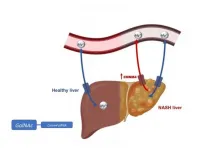Nerve damage after chemo: potential risk factors revealed
2021-03-04
(Press-News.org) Being older, overweight and having low haemoglobin levels (fewer red blood cells) could increase a patient's risk of developing debilitating nerve damage following chemotherapy, a research team led by UNSW Sydney has revealed.
The researchers aimed to identify pre-treatment clinical and blood-based risk factors in patients who developed chemotherapy-induced peripheral neuropathy (CIPN) - nerve damage in peripheral body parts, like hands or feet, as a result of chemotherapy.
The study, published in JAMA Network Open recently, examined patients - mostly women - who received paclitaxel or oxaliplatin chemotherapy treatment, which are common treatments for breast, colorectal and gynaecological cancers.
Lead author Dr David Mizrahi, of the Prince of Wales Clinical School at UNSW Medicine & Health, said: "One in two Australians will be diagnosed with cancer by age 85, including 145,000 new cases each year. Thankfully many survive, but side effects as a result of life-saving treatments are less talked about.
"CIPN is damage to the nerves that can impact your sensation and muscle control, generally in the hands and feet. This can have major implications for those who work with their hands and can impair balance, which can become an even bigger problem for older patients who are then at increased risk of falls. Many patients experience painful symptoms too.
"There are few established risk factors for this nerve damage. We found patients with low haemoglobin at the beginning of treatment, and those who had higher body mass indexes (BMI), were more susceptible to developing nerve damage. Older patients seemed to be more at risk, too."
The study's senior author Professor David Goldstein, Conjoint Clinical Professor at UNSW's Prince of Wales Clinical School, said past studies also showed older patients and those with a higher BMI, in both healthy adults and those with conditions such as diabetes, may be prone to developing nerve damage.
"Importantly, this work was stimulated by two committed consumers from the Australasian Gastro-Intestinal Trials Group who had identified that haemoglobin or iron levels may be a modifiable factor," Prof. Goldstein said.
"Fortunately, we were in a position to examine this within our wider Cancer Institute NSW-funded CIPN research program led by Associate Professor Susanna Park of The University of Sydney and myself.
"In our recently reported Australian cross-sectional survey of more than 950 patients exposed to neurotoxic chemotherapy, 75 per cent of respondents reported CIPN-related symptoms, emphasising the importance of this issue."
Prof. Goldstein said: "There are likely a range of factors that contribute to a patient developing CIPN - such as genetics, treatment dose, nutritional status, comorbidities.
"So, our findings add a new perspective to the current knowledge that patients who receive these types of chemotherapy could have a range of contributing factors putting them at an increased risk of nerve damage.
"Our findings could help cancer doctors and nurses to identify those who merit either a modified more tailored management approach or much closer and more intensified monitoring for the development of symptoms. This work will also assist medical teams to reduce the long-term severity of symptoms and positively impact patients' quality of life."
Laying the foundations for future research
The UNSW-led research team recruited 333 adult patients receiving paclitaxel and oxaliplatin chemotherapy in hospitals and cancer clinics in Sydney and Brisbane between September 2015 and February 2020. The median age was 58 years old.
About 80 per cent of those recruited were women, because females make up a significant proportion of patients with breast or gynaecological cancers.
Most patients had advanced stages of cancer, including some who were returning for relapse treatment.
The researchers analysed initial pre-treatment blood samples from patients before they started chemotherapy and comprehensively assessed participants for nerve damage three to 12 months post-treatment, then compared the results.
Dr Mizrahi said the team's study was the largest to date to identify low haemoglobin as a potential contributing factor to cancer patients developing CIPN.
"This result now justifies future studies of the relationship between low haemoglobin, iron levels and CIPN, and whether opportunities for intervention before or during treatment could reduce the risk of developing CIPN," he said.
"For example, raising haemoglobin by transfusion or iron infusion before starting chemotherapy is a testable hypothesis. In addition, we are currently investigating other potential options for reducing the impact of CIPN, such as using exercise or prescription medications such as Duloxetine (an antidepressant) for people with known CIPN.
"We are also exploring the use of simple screening questionnaires at each patient's chemotherapy cycle in an attempt to pick up symptoms early, allowing for closer monitoring and opportunities to modify treatments or refer patients to appropriate members of the multi-disciplinary team - so, the burden of symptoms can be reduced."
Dr Mizrahi acknowledged further exploration of the findings was needed but said the team's research was a key step forward in developing predictive models for CIPN and appropriate clinical pathways for care, which remained an unmet need for an important problem.
"There are currently no preventative or treatment strategies for CIPN - so, if our findings are validated with further research, future studies could closely monitor patients to determine the impact of risk factors for developing CIPN and examine possible interventions," he said.
INFORMATION:
Find the study in JAMA Network Open: https://jamanetwork.com/journals/jamanetworkopen/fullarticle/2776440
ELSE PRESS RELEASES FROM THIS DATE:
2021-03-04
In a colourful solution to a dangerous problem, Australian scientists are adapting a component from cutting-edge solar cells to design a rapid, light-based detection system for deadly toxins.
While use of chemical warfare agents like sulfur mustard - better known as mustard gas - is banned internationally, we do rely on other strictly-controlled chemicals for agriculture, industry and throughout our daily lives, including fumigants like methyl iodide, which is used to control insects and fungi. The wrong amounts or incorrect use of these fumigants can be harmful to people and degrade the ozone layer.
Because it's invisible and doesn't smell, it's hard to tell whether there are dangerous amounts of methyl iodide present, and until ...
2021-03-04
An international team of researchers has identified the CNNM4 protein as a key regulator of magnesium in the liver and potential therapeutic target for non-alcoholic fatty liver disease, according to a study published in the Journal of Hepatology.
Non-alcoholic steatohepatitis, a form of fatty liver disease characterized by inflammation and liver fibrosis, is associated with obesity and has a worldwide prevalence of 1.7 billion people.
Unhealthy nutritional habits and dietary imbalances are recognized as causes of many diseases. Magnesium is widely available in both plant and animal foods; most vegetables, legumes, peas, beans, and nuts are rich in magnesium, as are some ...
2021-03-04
An exquisitely detailed global ocean model simulation from the National Center for Atmospheric Research (NCAR) has given scientists rare insight into where baby sea turtles may go in their "lost years" after they scramble off the sandy beaches where they are born and swim into the open ocean.
This look at a critically important period in the life cycle of endangered loggerhead turtles could help inform more comprehensive conservation efforts that encompass regions of the open ocean where young turtles grow, and not just the nesting beaches. It also pinpoints regions of the ocean that are important to study to better understand how to protect sea turtles. ...
2021-03-04
DALLAS, March 4, 2021 -- The rate of cardiovascular risk factors among Hispanic/Latino people living in the U.S. is very high, and while they are often aware of their health conditions, less than half of the Hispanic/Latino adults with history of stroke or transient ischemic attack (TIA) had healthy blood pressure and cholesterol, and about half had healthy blood sugar levels, according to new research published today in Stroke, a journal of the American Stroke Association, a division of the American Heart Association.
According to the American Heart Association, from 2015 to 2018, 52.3% of Hispanic men and 42.7% of Hispanic women aged 20 years and older had cardiovascular disease (CVD).
"It's a wake-up call for ...
2021-03-04
Bottom Line: Cancer survivors had a greater risk of reduced ambulatory function, which was associated with an increased risk of death.
Journal in Which the Study was Published: Cancer Epidemiology, Biomarkers & Prevention, a journal of the American Association for Cancer Research
Author: Elizabeth Salerno, PhD, MPH, assistant professor of surgery at Washington University School of Medicine in St. Louis, who conducted the research at the National Cancer Institute
Background: The diagnosis and treatment of cancer has been shown to be associated with poor functional health for common cancer types, such as those of the breast and prostate, but less is known about the association for other cancers, explained Salerno. "Given that cancer survivors are living longer than ever, ...
2021-03-04
A new study led by Washington University School of Medicine in St. Louis and the National Cancer Institute (NCI) has identified an association between slow walking pace and an increased risk of death among cancer survivors.
While the study does not establish that slow walking is a cause of death, the association persisted across at least nine tumor types. Investigators now call for more research into these relationships and whether targeted interventions such as physical activity programs could help cancer survivors improve their ability to walk and increase survival after cancer diagnosis and treatment.
The study, a collaboration between Washington University, the NCI of the ...
2021-03-04
The loss of seagrass in the waters around the UK is much higher than previously estimated. A new study published in Frontiers in Plant Science concludes that, with high certainty, at least 44% of the UK's seagrasses have been lost since 1936, of which 39% has been since the 1980s. This study is one of the first of its kind to bring together seagrass data from diverse sources and give a systematic estimate of the current and historic extent of seagrass, as well as seagrass loss in the UK.
The study was a collaboration between researchers at University College London, Kings College London, and Swansea University.
Seagrasses as climate change superheroes
Nature-based solutions are essential to mitigate the effects of the climate crisis, and seagrasses are highly ...
2021-03-04
(Boston)--Children in Zambia under age 5 die at a rate that is between nearly six to more than 10 times higher than those in the U.S; it is estimated at 40-75 per 1000, compared to 6.98 per 1000. Identifying why these children are dying is the mission of Rotem Lapidot, MD, assistant professor of pediatrics at Boston University School of Medicine (BUSM).
"Significantly, over 80 percent of all community infant deaths involved some form of delay. While it is impossible to know what would have occurred in the absence of such delays, the majority of infant deaths in Lusaka, the capital of Zambia, are from causes for which effective treatments currently exist," explained Lapidot, the corresponding author on the study ...
2021-03-04
The far-reaching mobility restrictions at the beginning of the Corona pandemic in March 2020 created a unique situation for atmospheric sciences: "During the 2020 lockdown, we were able to directly investigate the actual effects of drastic traffic restrictions on the distribution of air pollutants and on the emission of climate gases," says Innsbruck atmospheric scientist Thomas Karl. With his team, he has now published a detailed analysis of air quality during the first lockdown in the city of Innsbruck, Austria, in the journal Atmospheric Chemistry and Physics. "We find significantly greater decreases of air pollutants than of carbon dioxide, for example," the researcher says, summarizing the results. In the past year, some studies showed contradicting ...
2021-03-04
Tiny photonic devices could be used to find new exoplanets, monitor our health, and make the internet more energy efficient. Researchers from Chalmers University of Technology, Sweden, now present a game changing microcomb that could bring advanced applications closer to reality.
A microcomb is a photonic device capable of generating a myriad of optical frequencies - colours - on a tiny cavity known as microresonator. These colours are uniformly distributed so the microcomb behaves like a 'ruler made of light'. The device can be used to measure or generate frequencies with extreme precision.
In a recent article in the journal ...
LAST 30 PRESS RELEASES:
[Press-News.org] Nerve damage after chemo: potential risk factors revealed




